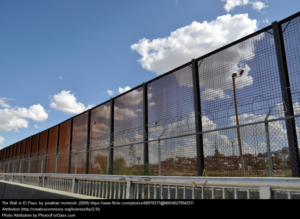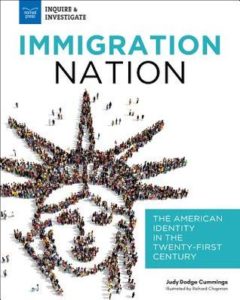“Helping Kids Understand the Immigration Debate”
The United States is a nation of immigrants. With the exception of Native Americans, everyone living here has immigrant ancestors hanging from their family tree. Many of you live or work or attend school with immigrants. Some of you see an immigrant when you look in the mirror.
For more than a century, the Statute of Liberty has stood in New York Harbor and held her torch aloft, beckoning the world’s “tired…poor…huddled masses” to enter America’s Golden Door. However, even though the United States celebrates its immigrant past in story and song, we still struggle with each successive wave of immigration. History shows us that when foreigners come by the millions to America’s shores, even when the United States needs their labor, there is inevitably a backlash from citizens who want to close the Golden Door.
Today, we are witnessing that struggle play out on the news and in our neighborhoods.
Images bombard us—caravans, checkpoints, and children in cages.
Our lexicon expands—catch and release, national emergency, amnesty, and illegals.
Leaders stake claim to the truth as they debate whether to build a wall to keep immigrants out or to build a path that helps immigrants stay. Meanwhile, citizens want to know whose “truth” is the truth?
In an age when we can select media outlets from a menu that matches our political leanings, we often hear only information that corroborates our world view. We learn about immigration through a one-sided filter, our views become hardened, and the nation remains divided.
Today’s teenagers are tomorrow’s decision makers. They will shape future immigration policy. They will have to determine if America’s Golden Door remains open or is closed.
I wrote Immigration Nation: The American Identity in the Twenty-First Century to help youth explore immigration through unbiased, factual sources. The book examines the nation’s long history of immigration and the role the law has played as gatekeeper. Statistics and anecdotes tell the story of who immigrates, why they come, and how these newcomers are treated. The book explores the political, economic, and social impacts of current and future immigration. My goal was to equip teens with the knowledge they need to reach their own conclusions about what future U.S. immigration policy should be so they can use evidence and logic when participating in our national conversation about this important issue.
Here are three activities I developed to help young people explore different aspects of United States immigration.
Activity: Graph the Numbers
Sometimes graphs are helpful when thinking about complicated information. Design a series of graphs to communicate the history of U.S. immigration. Locate data at the Digital Scholarship Lab’s interactive website.
What changes in immigration do you want to show? Consider the following factors.
- The rise and fall in the total number of immigrants from 1850 to 2010.
- The most common countries of origin of immigrants in 1850, 1950, and 2010.
- The percentage of the U.S. population that was foreign-born at different times in history.
What types of graphs most effectively illustrate these changes—a pie chart, bar graph, or line graph? Create a series of graphs and have a classmate try to read them. Are they successful?
To investigate more, choose one 50-year period between 1820 and 2010 and research the major world events that occurred then. What is the connection between these events and the trends in immigration at that time? How could you display these findings on a graph?
Activity: Graffiti as Protest
Throughout history, politicians have constructed walls to protect or divide, and people have created art on these walls to rebel and resist. In this activity, you will design art of a segment of the U.S. Mexican border wall that reflects your opinion of the state of immigration in the twenty-first century.
- Research different views of President Trump’s proposed border wall. Read the opinions of both Republican and Democratic lawmakers, economic analysts, environmental experts, immigration officials, and immigrant advocates.
- Decide what you think about the border wall. Is it needed? How much will it cost? How effective will it be? What does an extended border wall say about the United States? What are the psychological impacts of living behind a wall?
- Write a thesis statement to communicate your main opinion of the border wall. A thesis statement is usually a single sentence that summarizes your specific position on a subject.
- Brainstorm different ways you can artistically represent your thesis. How will you execute your ideas?
- Draw, paint, or sketch your ideas on a large piece of butcher paper. Display on a fence or wall so people can view your artistic expression.
To investigate more, research examples of border wall graffiti on walls around the world. What common themes or images are reflected by artists in different countries?
Activity: What’s on Your Plate?
Few Americans grow their own vegetables, milk their own cows, or butcher their own meat. We go to the grocery store, where almost any food is available any season of the year. Have you ever considered the lives of the people whose labor brings that food to your plate?
A 2014 report by the American Farm Bureau Federation found the agricultural industry needs between 1.5 and 2 million workers. Because not enough legal immigrants or American citizens will do backbreaking farm labor, 50 to 70 percent of agricultural workers are undocumented immigrants.
Explore the relationship between immigrant labor and the foods you eat. How much do you rely on farm workers?
- Keep a food diary for one week. What fresh fruit, fresh vegetables, milk, and meat do you regularly consume?
- Select one of these foods and research the role undocumented immigrants play in getting that item from the farm or field to the grocery store. What do immigrants say about their work experiences in places such as chicken processing plants or California fruit orchards? What makes the work difficult? What do they get paid for their work and how do their wages impact the price you pay at the grocery store?
- In a creative way, communicate the journey this food took. Consider a short story, comic strip, or storyboard. Share the story with you peers and discuss how Americans benefit from the labor of undocumented immigrants.
To investigate more, change your story so all the workers who produced your food were paid minimum wage. What impact would this have on you as a consumer?
More classroom resources can be found at https://nomadpress.net/wordpress/wp-content/uploads/2018/07/Immigration-Nation-Classroom-Guide.pdf.
Immigration Nation: The American Identity in the Twenty-First Century
Author: Judy Dodge Cummings
Illustrator: Richard Chapman
Published April 9th, 2019 by Nomad Press
About the Book: What does it mean to be an immigrant today? Has the immigrant experience changed since the last century?
Immigration Nation: The American Identity in the Twenty-First Century invites middle and high schoolers to explore the history of immigration in the United States, along with immigration law and statistics through the perspectives of immigrants, citizens, policy makers, and border agents.
For more than a century, an immigrant from France has stood vigil in the New York Harbor. At 350 feet tall, with a majestic spiked crown upon her head, a tablet of laws clutched in one hand and a torch held aloft in the other, the lady is hard to miss. She cries out to the world, “Give me your tired, your poor…I lift my lamp beside the golden door!” Millions of immigrants have answered the Statue of Liberty’s call, passing over, under, or through the Golden Door to become Americans.
However, on the eve of its 250th birthday, the United States is in the middle of an identity crisis. Should this land of immigrants open the door open to outsiders, people hungry for opportunity and desperate for freedom? Or should the country shut the golden door, barring entry to all but a select few? And what does it mean to be an American? How citizens answer these questions in the early twenty-first century will determine the future of America’s identity.
About the Author: Judy Dodge Cummings is a writer and former high school social studies teacher. She has written many books for children and teens, including Migration: Investigate the Global Journey of Humankind for Nomad Press. Lots of Judy’s books are related to history because that is her favorite topic to research, read, and write. Judy lives and writes in south central Wisconsin.
Website: judydodgecummings.com/books
Facebook: facebook.com/JDodgecummings
Thank you so much for this guest post!



